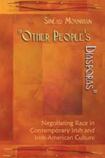
In French and Saunders' parody of Titanic, the star-crossed lovers Jack and Rose escape the stuffy elitism of the upper decks to experience the revelry of the steerage below. There they encounter Irish culture at its most "authentic": a boisterous bar, frenzied Irish music and, not least, a full-scale Riverdance troupe going through its paces.
Both Riverdance and transatlantic crossings, if not quite French and Saunders-style, feature in Sinéad Moynihan's Other People's Diasporas: Negotiating Race and Immigration in Contemporary Irish and Irish-American Culture. This welcome study is the first overview of the impact of multiculturalism and globalisation on recent Irish fiction, performance and film, and is a lively, critical engagement with the new self-images of an age. It includes, among its wide range of reference, discussions of the "Green Atlantic" fiction of Joseph O'Connor, Roddy Doyle's The Commitments (1987) and The Deportees (2007), Sinéad Moriarty's Whose Life Is It Anyway? (2008), plays by Ronan Noone (The Blowin of Baile Gall, 2006) and Donal O'Kelly (The Cambria: Frederick Douglass' Voyage to Ireland in 1845, 2005), Des Bishop's performances of the "New Irish" (particularly In the Name of the Fada, 2008), and films such as Eugene Brady's The Nephew (1998) and Jim Sheridan's In America (2004)
Central to the book is an intriguing aspect of representations of Ireland during the Celtic Tiger era, namely the displacement of many contemporary Irish concerns about race and immigration on to the historical experience of the Irish in the 19th century. As Moynihan points out, the unexpected reversal of the emigration-immigration balance in Ireland during the 1990s coincided with a decade of commemorations, in particular that of the Great Famine. The ship as metaphor of a deterritorialised nation looms large in O'Connor's Star of the Sea (2002) and O'Kelly's The Cambria, but the allegorical resonances between Ireland's colonial history and its contemporary status as a host culture for immigration carry even greater force.
At stake here is what Moynihan (borrowing from Steve Garner) terms the historical-duty argument, according to which the Irish, of all people, should be the last to adopt racist attitudes to others, by virtue of their own experience of emigration and discrimination over successive generations. This can provide an alibi for a sense of contemporary Irish victimhood, but analogies turn on difference as much as similarity, and the historical-duty argument is best served by drawing on the injuries of the past to ensure they are not inflicted on others in the present.
The lessons of history, sadly, are not always learned, and there is no shortage of Irish people turning their backs on cultural memory, often in the name of Irishness, as in the case of the "patriotic" racism of the character Eamon in Ronan Noone's The Blowin of Baile Gall, produced by Gabriel Byrne in New York but yet to be staged in Ireland.
John Ford claimed that while he rode (as a white man) with the cavalry, he also ran with the Indians (being no stranger to uprooting), and it is this ambivalence that underlies the complexity of Irish attitudes to race.
Given literature's ability to capture nuances of tone and irony, it is in a position to explore such ambiguities, and Moynihan's discussion is at its best when it attends to shifts in register and narrative voice. In her acute discussion of The Commitments she raises the question of whether Jimmy Rabbitte's "The Irish are the niggers of Europe. Say it loud, I'm black an' I'm proud" is stated with conviction or is meant to be taken ironically, in keeping with the constant undercutting of characters' pronouncements in Doyle's fiction.
That the concept of race is not without its own ambivalence is clear from her analysis, although it is not always teased out. Diane Negra's influential thesis that the appeal of Irishness in the United States is that it offers the prospect of a "guilt-free" whiteness to a privileged white culture with a far-from-unblemished past is deployed to telling effect, but at times it reads as if the sheer "fact" of the being white is sufficient to generate racist attitudes.
In her discussion of the film The Nephew Moynihan is careful to point out that the returned Irish-American, Chad, is not black (as most critics have described him) but is of mixed-race identity. This correctly challenges the equation of race (in this case blackness) with visibility, yet when it comes to whiteness there seems to be little room for whiteness of a different colour (in Matthew Frye Jacobson's formulation).
Irish racism emerges not from skin colour but from buying into (usually for purposes of social mobility) dominant ideologies that sought to define whiteness in racial terms, whether Wasp racial fantasies, the imperial “white man’s burden” or, more latterly, habits of authority from “Fortress Europe”.
In a rare false note Moynihan questions in another chapter why Des Bishop’s embrace of the Irish language does not highlight the “historical baggage – of nationalism and separatism some would say borders on xenophobia – it brings with it”, but there is no reason why Irish speakers should be any more xenophobic than speakers of other languages.
One of the most impressive aspects of Moynihan’s overall approach is her repeated warning against recasting Irish experience in terms of American debates of race and immigration, but it also follows that the Irish record in the US (or elsewhere) does not offer a template for the specificities of Celtic Tiger Ireland, although of course there are overlaps and affinities. As she points out, Bishop’s awareness of the idiosyncrasies of the Irish immersion heater played no small part in his eventual immersion in Irish culture itself, and her own close readings of Irish texts are similarly enhanced by an attentiveness to the small print of race and immigration in contemporary Ireland.
Luke Gibbons is professor of Irish literary and cultural studies at NUI Maynooth.










